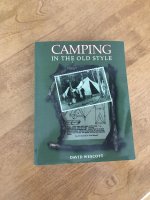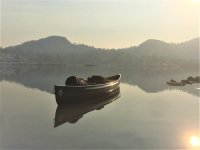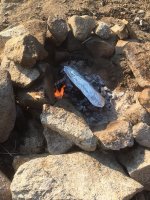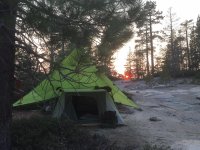-
Happy World UFO Day! 💫 🛸🤖👽
You are using an out of date browser. It may not display this or other websites correctly.
You should upgrade or use an alternative browser.
You should upgrade or use an alternative browser.
Camping in the Old Style by David Wescott
- Thread starter Robin
- Start date
Looks like an interesting read - I love old timey things - the way it usta was like I say to my kids. I could not trip last year due to my knee ... and this year I did get out but had to settle on a kevlar boat ( which I was glad to have - but missed my wood prospector terribly ). At least I can still portage like the old way people. I have found tumping my gear to be so much easier on me. My trip this early fall, late summer included ( from double porting ) about 20 miles of walking. Tumping my gear makes it much easier for me.
Here are Jake and I portaging in wolf country - so I keep him close ... lots of scat ( still steaming) and howls close by in the early am.
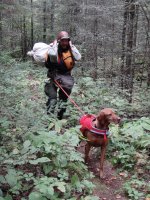
Here are Jake and I portaging in wolf country - so I keep him close ... lots of scat ( still steaming) and howls close by in the early am.

Peeking at that book seems useful
for the plasticheads too.
What happens in the bush when something breaks and you cant run to a store?
Only a tump fan sometimes but its nice for a change
I have a 60 l barrel and a harness with a tump for it
Plastic and old timey....
for the plasticheads too.
What happens in the bush when something breaks and you cant run to a store?
Only a tump fan sometimes but its nice for a change
I have a 60 l barrel and a harness with a tump for it
Plastic and old timey....
Last edited:
This just raises the question of how "old" does "old style" mean. The picture on the front cover of that book doesn't look that ancient to me. If it were really old, there would have been no camera to photograph the dress suited gentlemen.
I've often thought of starting a challenge thread to plan a canoe trip and gear from about 1700 -- meaning, no factory-made artificial materials. This would entail compiling a complete list of what everything would have been made of -- canoes, paddles, life jackets, tents, sleeping gear, kitchen gear, fire starting, clothing, etc. In fact, I'd like to go on such a trip.
I've often thought of starting a challenge thread to plan a canoe trip and gear from about 1700 -- meaning, no factory-made artificial materials. This would entail compiling a complete list of what everything would have been made of -- canoes, paddles, life jackets, tents, sleeping gear, kitchen gear, fire starting, clothing, etc. In fact, I'd like to go on such a trip.
G
Guest
Guest
I've often thought of starting a challenge thread to plan a canoe trip and gear from about 1700 -- meaning, no factory-made artificial materials. This would entail compiling a complete list of what everything would have been made of -- canoes, paddles, life jackets, tents, sleeping gear, kitchen gear, fire starting, clothing, etc. In fact, I'd like to go on such a trip.
That raises an interesting question. I don’t recall ever seeing a depiction or description of early trappers or voyageurs paddling with life jackets/PFD’s. Nor any birch-barkee native Americans with such a floatation device.
I have some vague recollection of Inuit hunters in kayaks carrying some kind of floatation aid, but I’m not sure about the intended use.
What/when is the early history of canoeist life jacket/PFD use?
Originally posted by Glenn MacGrady
I've often thought of starting a challenge thread to plan a canoe trip and gear from about 1700 -- meaning, no factory-made artificial materials. This would entail compiling a complete list of what everything would have been made of -- canoes, paddles, life jackets, tents, sleeping gear, kitchen gear, fire starting, clothing, etc. In fact, I'd like to go on such a trip.
That raises an interesting question. I don’t recall ever seeing a depiction or description of early trappers or voyageurs paddling with life jackets/PFD’s. Nor any birch-barkee native Americans with such a floatation device.
I have some vague recollection of Inuit hunters in kayaks carrying some kind of floatation aid, but I’m not sure about the intended use.
What/when is the early history of canoeist life jacket/PFD use?
The voyageurs and Indians weren't wimps like today's electrified, plasticized and petroleum-dependent canoeists. Neither were the Inuit kayakers, who also didn't use life jackets and relied on rolling in the frigid ocean to save their lives.
However, I assume some ancient paddlers must have used some sort of flotation devices. The only things I can think of are wood, cork, hollowed gourds and inflated animal bladders. The Inuits did use seal bladders for kayak flotation and and harpoon line buoyancy. I once saw a picture of a life jacket made of vertical sticks, but that may just have been an imagined modern creation of an ancient possibility.
"The earliest example of a life jacket or flotation device being used can be found on a marble carving in the British Museum from 870 BC, which shows Assyrian soldiers swimming while holding on to inflated animal skins."
https://cottagelife.com/general/a-br...e-life-jacket/
Edit to add picture:

https://cottagelife.com/general/a-br...e-life-jacket/
Edit to add picture:

Last edited:
G
Guest
Guest
I’m gonna guess that the first canoeist PFD’s were perhaps repurposed life jackets from ships, so maybe first cork, then kapok.
https://tinyurl.com/y24oogke
I am still struck when I look through some of paddling guides from the 1960’s or even ‘70’s how few PFD are shown worn in the photos.
https://tinyurl.com/y24oogke
I am still struck when I look through some of paddling guides from the 1960’s or even ‘70’s how few PFD are shown worn in the photos.
This just raises the question of how "old" does "old style" mean. The picture on the front cover of that book doesn't look that ancient to me. If it were really old, there would have been no camera to photograph the dress suited gentlemen.
I've often thought of starting a challenge thread to plan a canoe trip and gear from about 1700 -- meaning, no factory-made artificial materials. This would entail compiling a complete list of what everything would have been made of -- canoes, paddles, life jackets, tents, sleeping gear, kitchen gear, fire starting, clothing, etc. In fact, I'd like to go on such a trip.
Tundra, edited by Farley Mowat, is an interesting read about early arctic and subarctic travel. He took the personal accounts and records, which weren't/aren't readily available, of Hearne, McKenzie, Back, Tyrrell,Hornby and others, and edited them to make them a bit more readable. You get a good look at the methods of travel and camping that worked and those that didn't.
https://www.amazon.com/Tundra-Selec...26A7HXA4YMX&psc=1&refRID=QDNDZDXH526A7HXA4YMX
No one had a PFD that I can remember.
Alan
While I have not had a chance to get into this book yet, I’m pretty sure “Old Style” refers to the early 1900’s. If I remember correctly, not many “camped” before then, most time spent in the backwoods before then was for survival or financial reward. Correct me if I’m wrong.
I doubt PFD’s where part of the kit back then, in all the books about back country travel I have read I don’t remember flotation devices being mentioned.
What I like about this book is that it gives me the opportunity to study and learn the old styles, something I can put into practice while I camp out in the back country.
I doubt PFD’s where part of the kit back then, in all the books about back country travel I have read I don’t remember flotation devices being mentioned.
What I like about this book is that it gives me the opportunity to study and learn the old styles, something I can put into practice while I camp out in the back country.
At any rate Robin, you're old and you've got style, so it sounds like a perfect fit for you. It looks like an interesting read.
I learned how to camp and be in the outdoors from my Dad who is 95 years old. He still wants to go deer hunting. He learned from his Dad in the 1930s. I went to forestry school in the woods at UWashington where we had practical seminars in driving a D-9, throwing a surveryor' chain, building log houses. packing horses and mules and how to use dynamite. Then my Dad bought a cattle ranch in Arizona where everything was old school. It has been a common theme my whole life. I took some photos with sepia tone film on a mule packing trip in Wyoming. No one could tell if it way 1985 or 1885.
There is much to be learned about the old ways by reading the books of people that came before like Col Townsend Whelen, Brad Angier, Horace Kephart, Calvin Rutstrom, Elers Koch, Grey Owl, Nessmuk and so many others. Any decent library will have these kinds of books you can read for free.
That raises an interesting question. I don’t recall ever seeing a depiction or description of early trappers or voyageurs paddling with life jackets/PFD’s. Nor any birch-barkee native Americans with such a floatation device.
I have some vague recollection of Inuit hunters in kayaks carrying some kind of floatation aid, but I’m not sure about the intended use.
What/when is the early history of canoeist life jacket/PFD use?
As Glenn stated, the Inuit flotation devices were used to keep harpooned critters from diving. I don't think they considered PDFs. I also read that most all of the Inuit were unable to swim. Not that surprising on second thought. Where and when would they have practiced? But then again, if the predominant way to save one's hide was to roll the kayak one was in, how would they have practiced rolling their kayaks? In bays containing shallow, warm(ish) water in the summer?
Mike, you mentioned no one (or few) wearing PDFs in the 60' and 70'. I remember when seat belts in cars were introduced, and how weird those things were. I remember as a kid riding in a car the normal way. Not strapped to anything, sitting on my mom's lap on the passenger seat when we went someplace.
As far as old camping ways goes, I am not so sure folks back then wouldn't have used some of our currently available light weight gear and high-tech materials, given the chance. Wearing oil slickers and hauling heavy canvas around probably wasn't that great. I don't believe that just because something was used many decades (or longer) ago doesn't automatically make it superior. Perhaps that was all that was available. I have a mountaineering friend that firmly believes in the life saving properties of most high tech climbing gear available today, compared to the gear used a century ago. Don't get me wrong. I love traditional camping gear and I own some of it. A huge drawback to some modern gear canoeists use, is that it cannot be repaired in the bush, and I completely see the value in the 100% autonomous gear of the old days. Item were complete in and of themselves. No other gear or gadget or item was needed to make a piece if gear work, or if extra items were needed, like tent stakes or poles, they could be sourced right there. No batteries that went low or dead, no cell service or satellite service that was not available, no spray needed to make any high-tech cloth repel water. On the other hand, I can't but think that some modern influences, like light weight canoes and tents, affords at least some of us the opportunity for more frequent and unencumbered canoe tripping, as no pack animals or hordes of companion travelers are needed to schlepp some heavy gear around
I don't believe that just because something was used many decades (or longer) ago doesn't automatically make it superior.
I agree, but some folks (like me, and a few others I know of) enjoy surrounding themselves with gear from another era. I don’t think much if any of our kit is better than the equipment available today, and if you factor in the weight and extra maintenance, there’s no comparison to modern gear.
Old stuff is just too dependent on brute strength, certain diy repair skills, and extra trail skills to remain comfortable on the water and in camp for many folks.
Walk into a canoe shop where cedar and canvas are the principal materials used or visit an old barn where setting poles, leather tumps and ax handles are made makes one a believer in the “old style”.
Its like the old Harley Davidson saying, “If I have to explain, you wouldn’t understand”
Kind of a sidetrack here. Some of the new stuff makes up for the lack of outdoor ways most people have. Take PFD's. The Inuit never used them because if immersed in the ocean the only way to survival was to roll back up and get out of the water. The water was that cold that a wet exit was unfathonable.
And to prepare for the conditions they were in the kids were taught from a very young age the various braces and rolls. They were never allowed to paddle unsupervised without a balance brace.
Training started early and kept on for as long as they needed it until they were ready to survive on their own
I saw an Inuit rolling demo and lecture. The presenter was a world champion and very happy to show his old ways. 38 rolls. To cover each situation one might be in in case of injury or lost paddle etc.
One of my "idols" is Ray Rietze. He has given a few presentations and shown just how little he carries in the woods. He can actually repair a wood canvas canoe in the field no matter what the damage and also build sturdy structures.. And knows his plants and the uses for each. to this date in balsam country I never take bandaids and antiseptic.
It seems we have substituted the gear for the knowledge.
Robin have you seen this?
http://globalbushlife.com/portrait-quintessential-master-maine-guide/
And to prepare for the conditions they were in the kids were taught from a very young age the various braces and rolls. They were never allowed to paddle unsupervised without a balance brace.
Training started early and kept on for as long as they needed it until they were ready to survive on their own
I saw an Inuit rolling demo and lecture. The presenter was a world champion and very happy to show his old ways. 38 rolls. To cover each situation one might be in in case of injury or lost paddle etc.
One of my "idols" is Ray Rietze. He has given a few presentations and shown just how little he carries in the woods. He can actually repair a wood canvas canoe in the field no matter what the damage and also build sturdy structures.. And knows his plants and the uses for each. to this date in balsam country I never take bandaids and antiseptic.
It seems we have substituted the gear for the knowledge.
Robin have you seen this?
http://globalbushlife.com/portrait-quintessential-master-maine-guide/
Last edited:
"Substituted gear for knowledge" indeed.
People expect cell phone coverage and can't find it. They bring all kinds of gps and other navigation equipment and run out of batteries. If they get lost, they expect someone to come and find them. Map and compass will never let you down. Act like your life depends on your good judgment out there because it does.
People expect cell phone coverage and can't find it. They bring all kinds of gps and other navigation equipment and run out of batteries. If they get lost, they expect someone to come and find them. Map and compass will never let you down. Act like your life depends on your good judgment out there because it does.
Completely agree with you, Robin.
I just spent the weekend canoeing and fishing one of my favorite lakes. My camp sports some light weight stuff, but I do light my fires with a fire striker, and I love the quality and comfort of my (poles and pegs included) canvas tent, so I schlepp it along almost every time I camp. . As you said. I can't really explain why it feels right, but it does.
. As you said. I can't really explain why it feels right, but it does.
Yellowcanoe,
I agree with "It seems we have substituted the gear for the knowledge."
We also substituted most everything else in our lives from how things used to be. Who still has the time, need or ability to spend a life time, or a good portion of it, learning and honing the outdoor skills needed to fix a canoe in the wild or roll a kayak 38 ways? I completely admire those who have those skills and I understand the historic and perhaps practical necessity for some. I also wish I'd posses some of those skills. As it is, I have to take measured shortcuts here and there to be able to enjoy the outdoors the best my time and abilities allow.
A concluding thought on modern gear. I do believe that besides some select benefits, much of it also allows for, or even invites, recklessness or a false sense of security. Crossing a large body of water in a canoe during high winds and waves is not a good idea whether one wears a PFD or not. Not bringing (and knowing how to use) alternate means of making a fire, when those matches got wet, or that high tech camp stove doesn't work, is simply foolish. Not to speak of knowing substitutes for TP, but I believe that's been discussed already at different threads
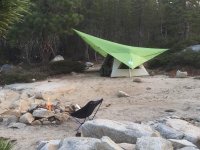
I just spent the weekend canoeing and fishing one of my favorite lakes. My camp sports some light weight stuff, but I do light my fires with a fire striker, and I love the quality and comfort of my (poles and pegs included) canvas tent, so I schlepp it along almost every time I camp.
Yellowcanoe,
I agree with "It seems we have substituted the gear for the knowledge."
We also substituted most everything else in our lives from how things used to be. Who still has the time, need or ability to spend a life time, or a good portion of it, learning and honing the outdoor skills needed to fix a canoe in the wild or roll a kayak 38 ways? I completely admire those who have those skills and I understand the historic and perhaps practical necessity for some. I also wish I'd posses some of those skills. As it is, I have to take measured shortcuts here and there to be able to enjoy the outdoors the best my time and abilities allow.
A concluding thought on modern gear. I do believe that besides some select benefits, much of it also allows for, or even invites, recklessness or a false sense of security. Crossing a large body of water in a canoe during high winds and waves is not a good idea whether one wears a PFD or not. Not bringing (and knowing how to use) alternate means of making a fire, when those matches got wet, or that high tech camp stove doesn't work, is simply foolish. Not to speak of knowing substitutes for TP, but I believe that's been discussed already at different threads

Attachments
- Joined
- Jan 7, 2016
- Messages
- 940
- Reaction score
- 874
The powers that be at my former place of employment got all excited about business cards. I had never seen one so asked what it should be written on it. The answer was name, title, work address and phone number. I was also told that it was acceptable to put a favorite quote on the back. My quote was,
"Good judgement comes from experience, and a lot of that comes from bad judgement." Will Rogers
"Good judgement comes from experience, and a lot of that comes from bad judgement." Will Rogers
Similar threads
- Replies
- 100
- Views
- 14K
- Replies
- 14
- Views
- 886
- Replies
- 23
- Views
- 4K

